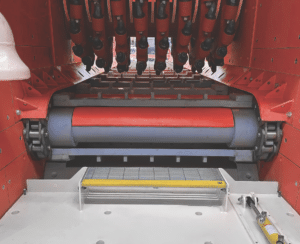The evolution of feeder-breaker technology is transforming mining operations by improving efficiency and safety.
The consistent and efficient processing of run-of-mine (ROM) materials is crucial in mining operations to minimise downtime, reduce operational costs and enhance overall productivity.
Feeder-breakers have long been a staple in this industry, combining the roles of a primary crusher and a feeder in a single unit.
As the mining industry evolves, so too does the technology that supports it, and the modern feeder-breaker is a testament to this advancement.
A feeder-breaker is designed to receive ROM material and break it down to a size more easily managed by downstream processing equipment.

Image: McLanahan
Combining two machines in one, a feeder-breaker consists of a drag chain type feeder with a rotating breaker head at one end. The material is dumped or loaded directly onto the feeder portion of the machine, which then meters it toward the breaker head for breaking the lumps into smaller sizes.
This dual functionality simplifies the mining process, reducing the need for multiple pieces of equipment and minimising material handling time.
The result is a more streamlined and efficient operation that also enhances the overall sustainability of mining operations.
One of the key features of modern feeder-breakers is adaptability. These machines can be equipped with single or dual drag chain conveyors sized to various lengths and widths, the design of which can be tailored to suit different mining environments.
For example, feeder-breakers can be configured for both dump hopper and dozer push designs and as flat-bed or goosenecked units, depending on the specific requirements of the site.
This flexibility ensures that feeder-breakers can be used in a wide range of applications, from coal mining to the processing of other friable materials.
“Feeder-breakers can be customised for different mining setups,” McLanahan sales specialist – crushing and screening Brad Anstess told Australian Mining.
“Whether it’s changing the feeding methods or adjusting the conveyor designs, this flexibility ensures they deliver top performance no matter the scenario.”
The breaker head, a crucial component of the feeder-breaker, is also customised for each application to ensure proper sizing.
Improper or inconsistently sized material can cause significant issues as it moves through the processing line, potentially leading to equipment damage, blockages and delays.
These problems not only affect the overall product quality but also increase downtime and operational costs. The design of each breaker head then depends on the size of the material it will process.

Image: McLanahan
Replaceable carbide-tipped picks – or teeth – are sized specifically for each application and then installed in a lace pattern around a pick roll for precise material reduction.
These rolls come in various styles, diameters and lacing pattern configurations to meet the specific requirements of each application.
Additionally, the breaker head can be raised or lowered to further adjust to the material size required.
The design of feeder-breakers has also been optimised to improve maintenance and operational efficiency.
Modern units often feature varying designs for rear door access as well as drop-down discharge end doors that can serve as working platforms covering the discharge chute aperture.
These features allow easier maintenance and inspection and reduce downtime during change-out.
In addition to these practical benefits, modern feeder-breakers are designed with safety in mind.
They are equipped with various safety features, including automatic chain tensioning systems, non-contact thermal switches and automatic hydraulic access doors. These innovations help protect both the equipment and the operators, ensuring a safer working environment.
“Innovative safety features not only protect operators, but also ensure the longevity and reliability of the equipment, which is crucial for maintaining productivity in mining operations,” Anstess said.
For over 185 years, McLanahan has been a leader in mining equipment manufacturing, providing innovative solutions in areas such as crushing, feeding, scrubbing, and tailings and water management.
With a strong emphasis on safety and sustainability, McLanahan leverages its expertise to address the ongoing challenges faced by the mining industry today.
This feature appeared in the September 2024 issue of Australian Mining.




